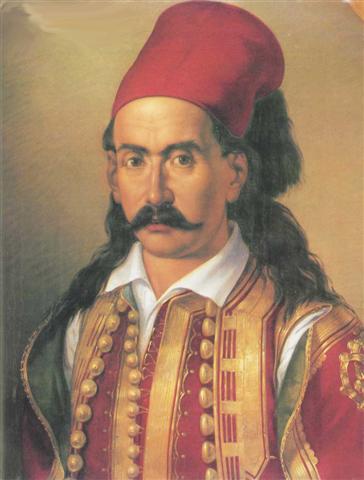| Revision as of 17:45, 26 February 2009 view sourceCplakidas (talk | contribs)Autopatrolled, Extended confirmed users, File movers, New page reviewers, Pending changes reviewers222,159 edits →Gallery← Previous edit | Revision as of 04:51, 4 March 2009 view source ΚΕΚΡΩΨ (talk | contribs)9,765 edits You've got to be joking.Next edit → | ||
| Line 12: | Line 12: | ||
| }} | }} | ||
| '''Markos Botsaris''' ({{lang-el|Μάρκος Μπότσαρης |
'''Markos Botsaris''' ({{lang-el|Μάρκος Μπότσαρης}}, c.1788 - August 21, 1823), was a leader of the ], an autonomous Albanophone Greek Orthodox community in Ottoman-held ], who played an important role in the ]. | ||
| Born in the region of ] in ], he was the second son of captain ] who was murdered in ] in 1809 by order of ]. They came from the village of Dragani (today Ambelia), near ]. In 1803, after the capture of Souli by Ali Pasha, Botsaris with the remnants of the ], crossed over to the ], where he ultimately took service in a ] regiment. | Born in the region of ] in ], he was the second son of captain ] who was murdered in ] in 1809 by order of ]. They came from the village of Dragani (today Ambelia), near ]. In 1803, after the capture of Souli by Ali Pasha, Botsaris with the remnants of the ], crossed over to the ], where he ultimately took service in a ] regiment. | ||
| Line 37: | Line 37: | ||
| {{Greek War of Independence|state=collapsed}} | {{Greek War of Independence|state=collapsed}} | ||
| {{Cham Albanians}} | |||
| {{Persondata | {{Persondata | ||
| |NAME=Botsaris, Markos | |NAME=Botsaris, Markos | ||
Revision as of 04:51, 4 March 2009
| Markos Botsaris | |
|---|---|
 | |
| Allegiance | Greece |
| Years of service | 1821-1823 |
| Battles / wars | Greek War of Independence |
Markos Botsaris (Template:Lang-el, c.1788 - August 21, 1823), was a leader of the Souliotes, an autonomous Albanophone Greek Orthodox community in Ottoman-held Epirus, who played an important role in the War of Greek Independence.
Born in the region of Souli in Epirus, he was the second son of captain Kitsos Botsaris who was murdered in Arta in 1809 by order of Ali Pasha. They came from the village of Dragani (today Ambelia), near Paramythia. In 1803, after the capture of Souli by Ali Pasha, Botsaris with the remnants of the Souliotes, crossed over to the Ionian Islands, where he ultimately took service in a French regiment.
In 1814, he joined the Greek patriotic society known as the Filiki Eteria, and in 1820, with other Souliots, made common cause with the Greeks against the Ottoman Empire. On the outbreak of the Greek revolt, he distinguished himself by his courage, tenacity and skill as a partisan leader in the fighting in western Hellas, and was conspicuous in the defence of Missolonghi during the first siege (1822-1823). On the night of August 21, 1823 he led the celebrated attack at Karpenisi of 350 Souliots on 1000-1500 Muslim Albanians who formed the vanguard of the army with which Mustai Pasha was advancing to reinforce the besiegers. Botsaris managed to take Mustai Pasha as a prisoner during the raid but he was shot in the head while leaving the encampment.
Many Philhellenes visiting Greece admired Botsaris' courage and numerous poets wrote poems about him. American poet Fitz-Greene Halleck wrote a poem entitled Marco Bozzaris, Juste Olivier also wrote an award-winning poem for him, in 1825. His memory is still celebrated in popular ballads in Greece. Markos's brother Kostas (Constantine) Botsaris, who fought at Karpenisi and completed the victory, lived to become a general and senator in the Greek kingdom. He died at Athens on the 13 November 1853. Markos's son, Dimitrios Botsaris, born in 1813, was three times minister of war during the reigns of Otto of Greece and George I of Greece. He died at Athens on 17 August 1870.
His daughter, Katerina "Rosa" Botsaris, was in the service of Queen Amalia of Greece. She was an admired young woman at European courts beauty of whom was immortalised by painter Joseph Stieler in 1841. The painting was part of the collection Schönheitengalerie commissioned by Ludwig I of Bavaria. The woman depicted in the painting posing in the attire named the "Amalia dress" is often mistaken for Queen Amalia herself. A Damask rose species bred in 1856 was named Rosa Botsaris after her.
Gallery
-
An oil painting on canvas of Markos Botsaris by Jean-Léon Gérôme, 1874.
-
 Tomb of Markos Botsaris, monument created by French sculptor David d'Angers, Messolonghi, Greece.
Tomb of Markos Botsaris, monument created by French sculptor David d'Angers, Messolonghi, Greece.
-
 The death of Markos Botsaris. Painting by Ludovico Lipparini, Civico Museo Sartorio, Trieste, Italy.
The death of Markos Botsaris. Painting by Ludovico Lipparini, Civico Museo Sartorio, Trieste, Italy.
References
Sources
 This article incorporates text from a publication now in the public domain: Chisholm, Hugh, ed. (1911). Encyclopædia Britannica (11th ed.). Cambridge University Press.
This article incorporates text from a publication now in the public domain: Chisholm, Hugh, ed. (1911). Encyclopædia Britannica (11th ed.). Cambridge University Press. {{cite encyclopedia}}: Missing or empty|title=(help)- Botsaris, 180 Years from the Greek Revolution